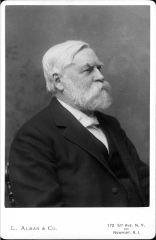woman’s magazine, wrote and translated half a dozen books, and assisted her husband in his research and writing.
Conant’s sound educational philosophy appeared clearly in his
Inaugural Address in which he declared:
The candidate for the ministry needs the same intellectual training as those who are preparing for other professions…in short, whatever belongs to the course of liberal education.
A capable teacher as well as scholar, he commanded the respect of his students. One of them confessed, “I did think I knew something about the Bible but Prof. Conant is fast convincing me to the contrary….”*To greet him on the evening of his return to Hamilton in 1843 after a year’s study in Germany, the students escorted him en masse from the village to his home on the campus, “Beech Grove,” and held a special assembly in the chapel in his honor. They also placed candles in all the windows of the buildings on the Hill, even breaking into unoccupied rooms to make their illumination complete.
The devoted Hascall resigned from the faculty in 1836. As Professor of Sacred Rhetoric since 1832, he had probably been teaching the English courses, particularly those relating to the preparation and delivery of sermons, as well as Latin. He had also been supervising the preparatory department. Not content merely with these duties, he had attempted to establish a manual-labor school at Florence, New York, which he hoped would be a feeder to the Institution. Deeply in debt, much of which seems to have incurred directly or indirectly in the service of the Education Society, and bowed down by family difficulties, he decided to devote all his energies to the enterprise in Florence. The Board, in accepting his resignation, revealed genuine appreciation of his sacrifices not only by passing resolutions of affectionate regard but also by assuming part of his indebtedness.
Through some undisclosed misfortune of which Hascall gave only a hint in a letter a few years later, his manual-labor school failed after a brief existence. Moving to Vermont, he occupied himself in managing the large farm of his second wife (his first, Sophia, the “Students’ Friend,” having died in 1836) and with collecting funds for the American and Foreign Bible Society. Unhappy with his lot he longingly thought of the Seminary and his friends in New York State. “I have
*Hezekiah Harvey to Lucy W. Loomis, Manilus, N.Y., Nov. 28, 1845.







